

Online Edition
Only for historical reference.

|| The Changing Landscape of Topographic Mapping
|| What is a Topographic Map?
||
|| Topographic mapping and the USGS
|| Common Mapping Scales
||
|| The USGS and the Mapping of America
|| What's in a Name?
||
|| Map Separates
|| The Digital Mapping Revolution
||

The U.S. Geological Survey (USGS) produced its first topographic map in 1879, the same year it was established. Today, more than 100 years and millions of map copies later, topographic mapping is still a central activity for the USGS. The topographic map remains an indispensable tool for government, science, industry, and leisure.
Much has changed since early topographers traveled the unsettled West and carefully plotted the first USGS maps by hand. Advances in survey techniques, instrumentation, and design and printing technologies, as well as the use of aerial photography and satellite data, have dramatically improved mapping coverage, accuracy, and efficiency. Yet cartography, the art and science of mapping, may never before have undergone change more profound than today.
A mapping revolution is underway. New technologies are altering the production and use of traditional maps. Even more significantly, the information age has introduced a new cartographic product that is changing the face of mapping: digital data for computerized mapping and analysis.
The computer is extending mapping beyond its traditional boundaries. New applications emerge with each technological advance. At their most basic, digital data applications make it possible to display maps on a computer, even a home personal computer. At their most advanced, digital data applications stretch the definition of cartography.
This booklet examines topographic mapping and the USGS in this changing cartographic world. It describes the topographic map, its use, its history, its production, and—in light of new technology and the digital mapping revolution—its potential.
|| Top ||

Whether on paper or on a computer screen, a map is the best tool available to catalog and view the arrangement of things on the Earth's surface. Maps of various kinds—road maps, political maps, land use maps, maps of the world—serve many different purposes.
One of the most widely used of all maps is the topographic map. The feature that most distinguishes topographic maps from maps of other types is the use of contour lines to portray the shape and elevation of the land. Topographic maps render the three-dimensional ups and downs of the terrain on a two-dimensional surface.
Topographic maps usually portray both natural and manmade features. They show and name works of nature including mountains, valleys, plains, lakes, rivers, and vegetation. They also identify the principal works of man, such as roads, boundaries, transmission lines, and major buildings.
The wide range of information provided by topographic maps make them extremely useful to professional and recreational map users alike. Topographic maps are used for engineering, energy exploration, natural resource conservation, environmental management, public works design, commercial and residential planning, and outdoor activities like hiking, camping, and fishing.
|| Top ||

A longstanding goal of the USGS has been to provide complete, large-scale topographic map coverage of the United States. The result is a series of more than 54,000 maps that cover in detail the entire area of the 48 contiguous States and Hawaii.
Produced at a scale of 1:24,000 (some metric maps are produced at a scale of 1:25,000), these maps are commonly known as 7.5-minute quadrangle maps because each map covers a four-sided area of 7.5 minutes of latitude and 7.5 minutes of longitude. The United States has been systematically divided into precisely measured quadrangles, and adjacent maps can be combined to form a single large map. The 7.5-minute quadrangle map series is popular as a base for maps of many different types and scales.
Because of its large land mass and sparse population, the primary scale for mapping Alaska is 1:63,360 (1 inch represents 1 mile). Each Alaska map quadrangle covers 15 minutes of latitude. The areas covered by these maps vary from 20 to 36 minutes of longitude, depending on location. There are 2,700 maps in the Alaska 15-minute quadrangle series.
In addition to the 1:24,000-scale maps, complete topographic coverage of the United States is available at scales of 1:100,000 and 1:250,000. Maps are also available at various other scales.
The amount of detail shown on a map is proportionate to the scale of the map: the larger the map scale, the more detail shown. Since 1 inch on the map represents 2,000 feet on the Earth, 1:24,000-scale maps depict considerable detail. Such large-scale maps of developed areas show features like schools, churches, cemeteries, campgrounds, ski lifts, and even fence lines. Many of these features are generalized or omitted in smaller scale topographic maps.
|| Top ||
Topographic maps are not the only cartographic products available from the USGS. The USGS publishes and distributes a variety of special-purpose maps. Some of these are topographic-bathymetric maps, photoimage maps, satellite image maps, geologic maps, land use and land cover maps, and hydrologic maps. Each type of map has a distinct purpose and appearance and, like topographic maps, all are available to the public for the cost of reproduction and distribution. USGS maps are not copyrighted.
Information on the types of maps produced by the USGS can be found in the USGS "Catalog of Maps."

|
7.5 minute 1:24,000 scale, 1 inch represents 2,000 feet |
1:100,000 scale, 1 inch represents about 1.6 miles |
1:250,000 scale, 1 inch represents about 4 miles |
|| Top ||

|
Planetable surveying by turn-of-the-century USGS topographers |
Initially charged by Congress with the "classification of the public lands," the USGS began topographic and geologic mapping in 1879. Most of the early USGS mapping activities took place in the vast, largely uninhabited Western United States.
Extreme challenges awaited these mapping pioneers. Travel was arduous and costly. Many locations could be reached only by mule pack train. Furthermore, surveying and mapping instruments were crude by today's standards. Most maps were made using a classic mapping technique called planetable surveying.
Planetable surveying took great skill and, depending on the mapping site, equal daring. Carrying a planetable—essentially a portable drawing board on a tripod with a sighting device--the topographer would climb to the area's best vantage point and carefully plot on the map those features that could be seen and measured in the field. Planetable surveying remained the dominant USGS mapping technique until the 1940's, when it gave way to the airplane and the age of photogrammetry.
|| Top ||
Mapmaking entered a new era with the use of aerial photographs and the development of photogrammetry. Photogrammetry is the science of obtaining reliable information by measuring and interpreting photographs.
The use of aerial photographs for mapping was pioneered in the 1930's, when the USGS assisted the Tennessee Valley Authority in mapping its area of responsibility. This project was the first full-scale test of the use of aerial photographs in creating maps. Aerial photographs increased dramatically during World War II when its use proved crucial for gathering military intelligence. Aerial photographs and photogrammetry led to a revolution in mapmaking. This change has significantly increased map coverage and enhanced map standardization.
|
Overlapping aerial photographs provide stereoscopic coverage of areas to be mapped. |
Producing an accurate topographic map is a long and complex process. It can take 5 years from the identification of a mapping requirement to the printing of a large-scale map like one of the USGS 7.5-minute, 1:24,000-scale quadrangle maps. This process requires a team of professionals and a series of closely coordinated steps.
A closer look at the procedures traditionally involved in topographic mapmaking demonstrates the combination of science, technology, and artistry required to produce a USGS map.
|| Top ||
The first step in producing a topographic map is acquiring aerial photographs of the area being mapped. A pair of aerial photographs--each showing the same ground area taken from a different position along the flight line--are viewed through an instrument called a stereoscope, producing a three-dimensional view of the terrain from which a cartographer can draw a topographic map.
Most photographs used for the USGS's topographic mapping program are now obtained through the National Aerial Photography Program (NAPP). NAPP flights are flown in a north-south direction along carefully determined flight lines. It takes 10 precisely positioned NAPP aerial photographs to provide the stereoscopic coverage needed for each 7.5-minute quandrangle map.
Every aspect of the aerial photography process requires precision and meticulous planning.
Specialized cameras are used to meet the exacting geometry needed to faithfully reproduce the stereoscopic model. Such a camera can cost more than $250,000.
To ensure that all NAPP photographs are at a scale of 1:40,000, NAPP flights are flown at a consistent altitude above the terrain.
Photographs must be taken when the sky is clear and with the Sun at the proper angle for the type of ground being photographed.
Even seasonal factors must be considered. In an area of hardwood forest, for example, it is usally best to take the photographs when leaves are off the trees so that terrain features are more clearly visible.
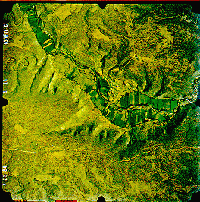
|
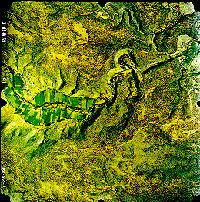
|
A pair of stereoscopic aerial photographs taken over Villanueva, New Mexico, in 1984. The originals were at a scale of 1:24,000, which are reduced here. Overlapping photographs such as these can be viewed through a stereoscope, resulting in a three dimensional view of the terrain to be mapped. |
|
|| Top ||
|
Information from field surveys is necessary to ensure the accuracy of maps. |
Technology has reduced the requirement for mapping work in the field. Gone are the days of planetable surveying when the topographer sketched the map by hand. Nevertheless, the field survey still plays an important role in making and revising topographic maps. After aerial photographs are obtained, field survey work may be required to establish and measure the map's basic control points and to identify objects that need visual verification.
Survey measurements are taken carefully to establish the control points that become the framework on which map detail is compiled. Two types of control points are needed to position map features accurately. Horizontal control points identify the latitude and longitude of selected features within the area being mapped. They establish correct scale and map orientation and allow accurate positioning of the map's features. Vertical control points determine the elevation of selected points for the correct placement of a topographic map's contours.
|
Markers such as |
Because engineers, highway officials, land use planners, and other professionals use USGS topographic maps as tools, map accuracy is vital. Dependable maps are also important to campers, hikers, and outdoorsmen.
The National Map Accuracy Standards were developed to ensure that Federal Government maps meet the high expectations and requirements of such users. Originally issued in 1941, the National Map Accuracy Standards apply to all Federal agencies that produce maps. These standards require horizontal and vertical map precision. For example, at least 90 percent of horizontal points tested on a 7.5 minute, 1:24,000-scale map must be accurate to within one-fiftieth of an inch on the map (40 feet on the ground). Vertical testing requires that at least 90 percent of the elevations tested must be accurate to within one-half the map's contour interval. For example, on a map with a contour interval of 10 feet, tested points must be within 5 feet of the actual elevation. These and other standards of accuracy and content ensure consistency in both the detail and the appearance of maps. They also ensure compatibility among USGS maps made at different times.
|| Top ||
Almost 2 million natural and manmade features are identified in the USGS topographic map series. These geographic names form a primary reference system essential for the communication of cartographic information. Beyond map labeling, geographic names are part of the Nation's living heritage. The origins and meanings of geographic names, derived from many languages, show national, personal, and social ingredients of life, past and present.
Some of the oldest geographic names found on U.S. maps are from Native American languages. Names like Adirondack, Chippewa, Chesapeake, Shenandoah, Choctaw, Yukon, and the names of 28 States are derived from various Native American languages. Other names reflect the European naming traditions of the early settlers. New London, Yorktown, Grover Hill, and Lancaster are derived from English; Fond du Lac, Baton Rouge, Marietta, La Salle, and St. Louis are French; El Mirage, Guadalupe, Rio Grande, San Francisco, and De Soto are Spanish names.
U. S. Geographic names are often rich in description, local color, and national history. Names like Stone Mountain, Ragged Ridge, Big Muddy River, Carmel-by-the-Sea, Grandview, and Long Island paint descriptive pictures of the places, features, and areas they represent. Last Chance, Hells Canyon, Liberty, Thief Lake, Enterprise, Rattlesnake Creek, Dread and Terror Ridge, and Paradise Flats evoke the dreams, fears, and color of the frontier.
The standardization of geographic names in the United States began late in the 19th century. The surge in mapping and scientific activities after the Civil War left the accuracy and spelling of a large number of names in doubt. This posed a serious problem to mapmakers and scientists who require nonconflicting nomenclature. The U.S. Board on Geographic Names was established in 1890 as the central authority to deal with naming conflicts. This interagency body, chaired by the U.S. Department of the Interior, helps standardize the spelling and application of geographic names on maps and documents published by the U.S. Government.
|| Top ||
Field personnel use aerial photographs to mark and verify map features. A field check is necessary because information on an aerial photograph can often be ambiguous. For example, a worker in the field can indicate the difference between a perennial stream and one that dries up at certain times of the year. This is necessary because a perennial stream would be marked with a solid line on a map while an intermittent stream is designated by either a dash-dot or lighter weight solid line on a map. People who know the local area well, such as fishermen or farmers, are excellent sources of such information.
Another important job in the field is the verification of place names and political boundaries. This work often requires looking at courthouse records and talking to local residents. It can even include a visit to the local cemetery to check the spelling of a feature that has been named after a person buried there.
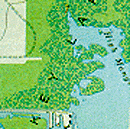
|
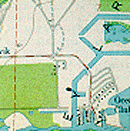
|
|
Significant changes in map content on successive editions of a map of Key Largo, Florida, illustrate why maps need revision. |
|
Upon completion of the field survey, the map manuscript is compiled using stereoscopic plotting instruments. Overlapping aerial photographs are placed in a special projector connected to a separate tracing table. The projected photographs are viewed through an optical system that causes the left eye to see one photograph and the right eye to see another. The result is a three-dimensional impression of the terrain.
Map features and contour lines are traced as they appear in the stereomodel. As the operator moves a reference mark, the tracing is transmitted to the tracing table, producing the map manuscript.
|| Top ||

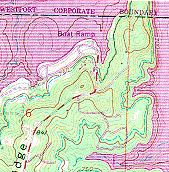 |
 |
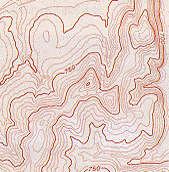 |
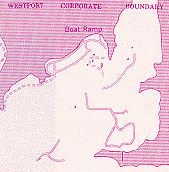 |
These illustrations show a portion of a USGS topographic map (top left) and three of the six colors used to print separate features. The green layer shows areas of woodland, and the brown layer shows topographic features, including contour lines. The purple layer shows features that are added from aerial photographs and other sources, but are not field checked. |
|
|| Top ||
After the map manuscript is compiled, several steps remain before a map is completed. First, a map-size film negative of the compiled manuscript is made. This negative is then photochemically reproduced on several thin plastic sheets to which a soft translucent coating (called scribecoat) has been applied. These serve as guides for scribing.
Working over a light table, the scriber then uses engraving instruments to etch the map's lines and symbols. This is done by removing the soft coating from the hard plastic guide sheet. All features to be printed in the same color on the map—such as blue for water features—are etched onto separate sheets. A map is edited several times before final scribed sheets are completed.
Type for the words on the map is selected according to standards that will ensure consistency of type sizes and styles from map to map. Type placement is important for map legibility, so type must be carefully positioned on clear plastic sheets that are overlaid on the scribed separations. Photographic negatives are made of the type for printing.
|
Printing plates are prepared for each separate color from scribed sheets, open widow negatives (above), and type sheets. |
The final step before printing is the preparation of a color proof. Multiple exposures are made of the type negatives and scribed sheets. The result looks very much like a finished map. Careful editing takes place for content, legibility, accuracy, and spelling. When the final proof is approved, the map is ready for printing.
A press plate is made for each map color by exposing the appropriate scribed sheets and type negatives. Printing is done by repeated runs of the map paper through the lithographic printing press (one for each color), or one run through a press capable of printing several colors in sequence. The largest USGS press prints up to five colors of ink on a single pass.
Most of today's topographic maps were made using these techniques, but computer technology will profoundly influence the craft of mapmaking. For example, map compilation and revision will be performed from digital images. Color separates will be plotted from digital data rather than manually scribed separates. Even the type for words on the map will be positioned and plotted from digital data.
|
Portion of Fort Smith, Arkansas, 7.5-minute quadrangle map made to current USGS standards for content, accuracy, symbols, and type. |
|| Top ||

Computer technology will not only change the way maps are made but how they are used.
Computer-assisted map production is making it easier to produce new paper maps and to revise existing ones. The USGS is responding with innovative ways of compiling map data and using them for map production. Many of the mapmaking processes described above are being changed or eliminated. Improved efficiencies in most facets of production will shorten the 4 to 5 years it takes to produce a map by traditional methods.
Widespread acceptance of computers and related technologies has accelerated the demand for mapping information in computer-compatible form. Government agencies and private businesses now require digital mapping information for their computer-based systems.
The goal of the USGS is to stay in the forefront of the technology that will modernize the production of traditional maps while responding to the growing need for data in digital form.
|| Top ||
Most of the USGS's digital map data are collected from existing topographic maps. The task is monumental.
Map digitization resembles the original map scribing process in that it requires that each feature on each map separate be located, classified, and traced. A map can have 10 or more different layers--roads, contours, boundaries, surface cover, and manmade features, for example--that require digitization. Maps can be digitized by hand, tracing each map's lines with a cursor, or automatically with scanners.
After digitizing, several editing operations remain. For example, attribute codes must be added to identify what each digitized line or symbol represents. A variety of other tasks must be performed to ensure that information is complete and correct, including matching features with adjoining files, matching features relative to each other within the file, and controlling the accuracy of attribute coding and positions.
The USGS is the principal agency developing standards and coordinating other matters related to Federal digital cartographic data. The National Digital Cartographic Data Base (NDCDB) was established by the USGS to distribute digital data that meet these standards for use in map production and in automated systems.
NDCDB data provide a framework of reference for other data about the Earth and its resources. The NDCDB data consists of digital line graphs ( DLG) and digital elevation models ( DEM). DLG's are the digital representation of information typically found on a topographic map (point locations, lines and area outlines). DEM's are matrices of elevations for ground points spaced at regular distances.
Nationwide DLG coverage is complete for transportation and hydrographic features found on 1:100,000-scale maps and for most information found on 1:2,000,000-scale maps. The 1:100,000-scale data served as the base for the Bureau of the Census Topologically Integrated Geographically Encoded Reference files--the digital representation of the Nation used in the 1990 census.
|| Top ||
Geographic information systems (GIS) are at the forefront of the mapping revolution. A GIS makes it possible to combine layers of digital data from different sources and to manipulate and analyze how the different layers relate to each other.
With a GIS, researchers can combine geographically referenced data from the NDCDB and many other sources and perform complex analyses that have not been possible before. GIS's are being used in applications as varied as:
Soil conservation.. The Department of Agriculture is combining DLG information with scanned photographs and field boundary data to report and analyze soil use.
Crime solving.. Police investigators link police record systems with geographic information to analyze crime patterns and help solve cases.
Emergency response planning. A GIS can be used to combine transportation and earth science information to help plan emergency response to a natural disaster, such as an earthquake. By merging information on the types of roads, locations of fire stations, and locations of faults, the anticipated response times of fire and rescue squads can be calculated both under normal conditions and following transportation blockages caused by an earthquake.
Marketing. Merging sales information with digital map data can help companies target markets or present sales information in geographic terms.
Whether used in government, business, military, or a host of other applications, a GIS provides the means to examine relationships in ways never before possible.
|
|
With today's technology, it is possible to generate personal maps on a home computer. In the near future, traffic jams may be avoided with dashboard-mounted computer mapping systems. Beyond that may lie interactive television where local news or weather reports can be chosen by touching a map on the screen.
Digital techniques will continue to influence mapmaking, enabling more rapid production of accurate, current maps. Computers can also help us manipulate data derived from traditional maps in increasingly sophisticated ways.

[an error occurred while processing this directive]

This online edition contains full text from the original publication. This document has undergone official review and approval for publications established by the National Mapping Division, U.S. Geological Survey. Some figures have been modified, added or deleted to improve the scientific visualization of information.

[an error occurred while processing this directive]